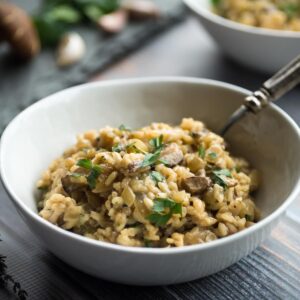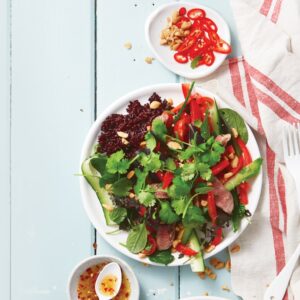
Choosing healthy ingredients is only half the story. As nutritionist Bronwen King explains, how you cook them will help make the most of their nutritional benefits.
Many a healthy dish has lost its way between the pantry and the plate. A splash of oil here, a dash of salt there, and before you know it your once-healthy meal has transformed into a not-so-healthy one.
Of course, a healthy meal starts with healthy ingredients: lean meat, fish, vegetables, fruit, low-fat dairy, nuts, seeds and legumes. But they need to be cooked in a way that maintains or enhances their nutritional value. Use the following techniques to make the most of your fresh ingredients and you’ll have a meal that ticks all the right boxes.
Steaming
Good to use for
- Vegetables such as leeks, courgettes, asparagus, Brussels sprouts, carrots, and particularly brassicas such as broccoli, cabbage and cauliflower
- Fish, mussels and other shellfish
- Vegetable dumplings or lean meat-filled dumplings
Steaming is a simple technique using either the stove top or the microwave.
Stove-top steaming involves cooking food in a perforated basket or steamer pan over boiling water (or other liquid).
Microwave steaming involves heating the water molecules in the food (and any added liquid) so they turn into steam to cook the food. An advantage of microwave steaming is the quick cooking time — so only a minimal amount of some nutrients which are degraded by heat are lost.
Why is it healthy?
Steaming generally only involves water and heat so there is no added fat or kilojoules. And since there is little liquid involved, the nutrients in the food don’t leach out into the cooking water.
Beware of
- Over-steaming. This can break down the texture of food and affect its colour, taste, appearance and most importantly, its nutritional value. If food (particularly vegetables) is steamed until it becomes mushy, a whole host of nutrients are lost. The trick is to steam veges for only a few minutes so they are bright coloured and tender-crisp. When steaming fish, steam until fish is just cooked through.
Get it right every time
- Equip yourself with a suitably-sized steamer pot and/or covered microwave dish.
- Ensure there is enough cooking liquid in the bottom of the pot so that it doesn’t boil dry. This will prevent ‘smoked vegetables’.
- Watch food closely to ensure it doesn’t overcook. To be ‘lightly steamed’, food is still slightly crunchy and the colour, shape, taste and the nutrient value is retained.
Poaching
Good to use for
- Chicken, fish
- Stone fruit, pears and apples
Poaching involves gently simmering food in water or a flavoursome liquid — such as wine, salt-reduced stock, vinegar or juice — until it is cooked through.
Why is it healthy?
Because food is poached in water, there aren’t any added kilojoules or fat. If you plan to use the poaching liquid as a sauce or broth, be sure to use reduced-salt or reduced-sugar liquids, or dilute them with water.
Beware of
- Using very salty or sweetened liquids. These can draw liquid out of the food making it dry, as well as deplete foods of their taste and nutrients. And using that sweet or salty liquid as part of a dish can significantly increase sodium or sugar levels.
Get it right every time
- Bring poaching liquid to a simmer then add meat or fruit and cook until tender — but not overcooked. To add more flavour to meat, try combining white wine with a little salt-reduced liquid stock.
- When poaching fruit, use fruit that is almost over-ripe to reduce the amount of added sugar, and enhance the flavour with fruit juice, vanilla pods or wine.
Stir-frying
Good to use for
- Lean, tender cuts of meats such as beef, lamb back strap, pork fillet, chicken breast
- Prawns, calamari, firm white fish
- Vegetables cut in small pieces
- Tofu
This popular cooking method involves quickly cooking meat and/or vegetables in a wok or frying pan over a high heat.
Why is it healthy?
Stir-frying requires only a spray of oil, which keeps the added fat and kilojoule count low. Since vegetables are cooked for just a few minutes, they retain their nutrients as well as their texture, flavour and colour.
Beware of
- Using too much oil. Oil spray is the best option. If more liquid is needed, add a little water or salt-reduced liquid stock.
- Overcooking vegetables and meat. These generally only need a few minutes to cook, especially when they’re thinly sliced. If using vegetables that take a while to cook (such as carrots, cauliflower and broccoli), steam them lightly first. Add in vegetables that will take the longest to cook first then add veges that take less time to cook (such as capsicums, onions and mushrooms).
Get it right every time
- Use a non-stick pan or wok which retains heat well, lightly spray with oil and place over a high heat before adding meat and/or vegetables.
- Stir-fry meat or tofu first and remove from wok before adding vegetables. Add spices or sauce(s) to the nearly-cooked vegetables then return meat or tofu to the pan and cook for a few minutes longer to finish cooking.
Grilling and barbecuing
Good to use for
- Lean, tender cuts of meat such as beef steak, lamb chops and pork chops
- Skinless chicken breasts and thighs, kebabs, lean sausages
- Vegetable slices/chunks such as capsicums, courgettes, eggplant and tomatoes
- Whole corn cobs
- Fruit such as halved nectarines, peaches, mangoes or bananas
Grilling involves cooking meat, vegetables and/or seafood under a direct heat, while barbecuing involves cooking over a direct heat.
Why is it healthy?
Cooking foods quickly over or under a high heat maximises flavour and avoids major nutrient loss. Both methods require adding very little (if any) fat, which helps keep the kilojoule and fat intake down.
Beware of
- Grilling meats without allowing the fat to drain away. This essentially shallow-fries the meat, which can lead to a higher fat consumption.
- Overly charring your food. While many people like the taste, recent studies have linked heavy charring to an increased risk of cancer. While the odd charred sausage, steak or capsicum shouldn’t be a cause for concern, if you barbecue or grill regularly, you need to avoid charring food too often.
Get it right every time
- Ensure the barbecue is clean and hot before adding food. Non-stick surfaces eliminate the need for added oil or fat.
- Trim excess fat from meat before cooking and ensure the fat can drip away as your food cooks. When grilling in the oven, place food on a rack over a tinfoil-lined tray.
- Lightly spray vegetables with oil.
- Marinating meats before cooking can have a tenderising effect as well as add flavour. Avoid marinades that are heavy on oil or fat — try using lemon juice, pineapple juice, balsamic vinegar, garlic and herbs.
Roasting and baking
Good to use for
- Large cuts of meat like lamb leg and shoulder, scotch fillet, pork leg
- Whole chickens or turkeys
- Root and starchy vegetables (potatoes, kumara, parsnips, swedes and pumpkins)
- Capsicums, onions, carrots and courgettes
Roasting and baking involve oven cooking using dry heat. Baking involves ‘dry cooking’ foods without using oil or fat, while roasting involves adding oil.
Why is it healthy?
Because baking doesn’t require any extra fat it’s the healthier cooking method. However, if using minimal amounts of heart-healthy oils (such as sunflower, olive or canola), roasting can also be a healthy option. Don’t forget to sit meat and vegetables on a roasting rack (with a tray or pan underneath) so food doesn’t sit in the drippings as it cooks.
Beware of
- Cooking vegetables around the meat. They act as sponges, soaking up any meat drippings.
- Assuming that oil is the only way to add flavour to roasts. Spices, herbs and other liquids such as salt-reduced stock and orange juice can add beautiful flavour.
Get it right every time
- Leave skins on vegetables to retain nutrients and bump up fibre intake.
- Trim all visible fat from your meat and remove skin from poultry and fish. Covering meat towards the end of cooking time will steam the meat to help tenderise it and retain moisture.
- Combine a little flour and spices/herbs in a plastic bag, spray vegetables and meat with oil, add to bag and shake to coat. Transfer meat and vegetables to a roasting dish to cook.
What about…?
Frying
Any cooking method that involves fat or oil has the potential to be unhealthy. A little olive or vegetable oil may have some health benefits but when it comes to fats, less is always best. Use good quality, non-stick pans to help keep the need for added fats to a minimum.
Boiling
Boiling vegetables for too long can not only result in lost nutrients, but over-boiled vegetables are often colourless and tasteless. However, quickly boiling vegetables in a small amount of unsalted water can be a healthy way to cook.
One food, six cooking methods
The choice of cooking method affects overall fat content. Nothing illustrates this better than a potato!
Per 100g potato
- Baked jacket potato = 0.3g fat
- Peeled and roasted potato = 5g fat
- Oven-baked wedges = 6g fat
- Fat chips from a fish & chip shop = 9g fat
- Shoestring fries = 15g fat
- Potato chips = 30g fat
www.healthyfood.com










